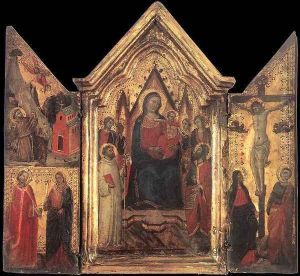Jacopo del Casentino Landini Paintings
Jacopo di Arcangelo, known as Jacopo del Casentino Landini, was an influential Italian painter from the early Renaissance period, born in 1297. Although not as widely recognized as some of his contemporaries like Giotto di Bondone, Jacopo's contributions to the development of Italian art during the 14th century were significant. Originating from the Casentino area, a valley in eastern Tuscany, his surname 'del Casentino' reflects his regional heritage. His works and contributions, however, extended beyond this locality, impacting the broader artistic landscape of the time.
Jacopo del Casentino's early life is shrouded in mystery, with scant documentation about his training or initial influences. However, it is widely believed that he was a part of the Florentine school of painting, which played a pivotal role in the transition from Medieval to Renaissance art. Jacopo’s style suggests that he was influenced by the works of Giotto, whose frescoes introduced more naturalistic figures and narratives, a departure from the stylized Byzantine traditions that dominated prior periods. Despite the lack of concrete evidence linking him directly as a pupil of Giotto, the stylistic similarities in their work suggest a strong influence, if not direct mentorship.
Throughout his career, Jacopo del Casentino worked on various commissions that included frescoes and panel paintings for churches and monasteries throughout Tuscany. One of his most notable projects was the decoration of the Eremo di Camaldoli, a hermitage near his hometown, where his frescoes depicted scenes from the life of St. Romuald, the founder of the Camaldolese Order. His work is characterized by its vivid color palette, attention to detail, and the emotional expressiveness of the figures, traits that became hallmarks of the early Renaissance style.
In addition to his painting, Jacopo del Casentino was also instrumental in the foundation of the Company of Painters in Florence, an organization that sought to protect the interests of artists and standardize the practice of painting. This initiative underscores his role not only as an artist but also as a key figure in the professionalization and organization of the arts during the Renaissance.
Jacopo del Casentino's death in 1358 marked the end of a career that had a lasting impact on the trajectory of Italian Renaissance art. Although he may not be as well-known as some of his contemporaries, his work contributed to the foundational shifts in artistic style and practice that characterized the period. Today, his surviving works, though limited, continue to be studied for their contribution to the development of Renaissance art and aesthetics.
